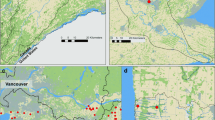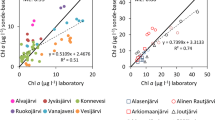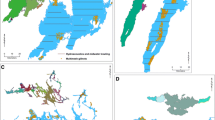Abstract
The Saimaa lake complex (4460 km2) is a mosaic of interconnected basins draining into the Gulf of Finland via Lake Ladoga. Limnologically, most of the basins are dysmesotrophic or oligotrophic, while some areas are markedly affected by nutrient loading. Aquatic research has been conducted in the Lake Saimaa area with the 27-metre research vessel R/V Muikku since 1989, and the laboratory and research facilities on the vessel have been built up and enhanced over this time to include temporally and spatially reliable automatic measuring systems such as CTD (ConductivityTemperatureDepth) probes and a continuous-flow in vivo fluorometer. This paper uses linear regression to compare vertical CTD measurements with standardised laboratory analyses of water temperature, O2 concentration, conductivity and pH in different basins of the Lake Saimaa complex from data sets collected on board R/V Muikku in 2000–2001, and tests in vivo automatic fluorometer measurements of filtered and unfiltered discrete water samples from the Haukivesi basin of Lake Saimaa against in vitro chlorophyll-a concentrations. All the linear regressions showed a significant overall consistency between the CTD and fluorometer results and the laboratory analyses, but the pH comparisons showed some instability between methods. Clear spatial and vertical variations in conductivity and oxygen concentrations were apparent in the CTD results for three basins (Lakes Pyhäselkä, Haukivesi and Etelä-Saimaa), and there was also a significant linear relationship of unfiltered and filtered in vivo fluorescence to in vitro chlorophyll-a concentrations. The unfiltered fluorometer measurements were nevertheless markedly higher than those obtained from filtered water samples. Thus humic and other dissolved substances in lake water may be said to yield enhanced fluorometer readings independent of the chlorophyll-a concentrations, as has been noted earlier in similar studies.
Similar content being viewed by others
References
Abbott, M. R., P. J. Richerson & M. Powell, 1982. In situ response of phytoplankton fluorescence to rapid variations in light. Limnol. Oceanogr. 27: 218–225.
Babin, M., J. C. Therriault, L. Legendre, B. Nieke, R. Reuter & A. Condal, 1995. Relationship between the maximum quantum yield of carbon fixation and the minimum quantum yield of chlorophyll a in vivo fluorescence in the Gulf of St. Lawrence. Limnol. Oceanogr. 40: 956–968.
Brown, N. L., 1974. A precision CTD microprofiler. IEEE Conference on Engineering in the Ocean Environment Vol. 2: 270–278.
Breemen, W. C. A., 1982. Comparison of fluorometric and spectrophotometric methods for in vivo chlorophyll determination. Arch. Hydrobiol. Beih. Ergebn. Limnol. 16: 25–34.
Chen, R. F. & I. L. Bada, 1992.The fluorescence of dissolved organic matter in seawater. Mar. Chem. 37: 191–221.
Ekholm, M., 1993. Suomen vesistöalueet. Vesi-ja ympäristöhallinnon julkaisuja. Sarja A 126: 166 pp.
Ernst, D. E. W., 1986. Comments on fluorometric chlorophyll determinations in the field. Arch. Hydrobiol. 107: 521–527.
Holopainen, A.-L., P. Huovinen & P. Huttunen, 1993. Horizontal distribution of phytoplankton in two large lakes in Eastern Finland. Verh. int. Ver. theor. angewand. Limnol. 25: 557–562.
Holopainen, A.-L., M. Viljanen & R. Lempinen, 2000. Fluorometer and CTD monitoring of the Vuoksi drainage basin, eastern Finland. Verh. int. Ver. theor. angewand. Limnol. 27: 2194–2197.
Huovinen, P., A.-L. Holopainen & P. Huttunen, 1994. Spatial variation of community respiration and primary productivity in two large lakes in Eastern Finland. Verh. int. Ver. theor. angewand. Limnol. 25: 2514–2518.
Jacobsen, T. R., 1982. Chlorophyll a measurements by fluorometric, spectrophotometric and high pressure liquid chromatographic methods in aquatic environments. Arch. Hydrobiol. Beih. Ergebn. Limnol. 16: 35–45.
Jacobsen, T. R., H. Rai & E. A. Nusch, 1988. The measurements of phytoplankton pigments in freshwater: where do we go from here? Verh. int. Ver. theor. angewand. Limnol. 23: 952–956.
Kolber, Z. & P. G. Falkowski, 1993. Use of fluorescence to estimate phytoplankton photosynthesis in situ. Limnol. Oceanogr. 38: 1646–1665.
Leppä, M., J. Karjalainen & A.-L. Holopainen, 1995. In vivo-fluorescence and chlorophyll a determination in Finnish humic lakes. Aqua Fennica 25: 33–38.
Mononen, P. & R. Niinioja, 1993. Nutrient and chlorophyll concentrations in the northern part of Lake Saimaa, Finland. Verh. int. Ver. theor. angewand. Limnol. 25: 544–547.
Perkin, R. G. & E. L. Lewis, 1982. Design of CTD observational programmes in relation to sensor time constants and sampling frequencies. Institute of Ocean Sciences, Patricia Bay, Sidney, B.C., Canada. Canadian Technical Report of Hydrography and Ocean Sciences No.7: 47 pp.
Peters, H., 1976. GATE-CTD data measured on the FRG ships. Shipboard operation-calibration-editing. Berichte der Institut für Meereskunde, Kiel, Volume 22: 16 pp.
Poryvkina, L., S. Babichenko, S. Kaitala, H. Kuosa & A. Shalapjonok, 1994. Spectral fluorescence signatures in characterization of phytoplankton community composition. J. Plankton Res. 16: 1315–1327.
Premazzi, G., G. Borsani, A. C. Cardoso G., Chiaudani, C. Defranceco, K. Kallio, K. Petterson, D. Pierson, & E. Rodardi, 1999. Methods in Limnology. In Lindell, T., D. Pierson, G. Premazzi & E. Zilioli (eds), Manual for Monitoring European Lakes Using Remote Sensing Techniques. EUR 18665 EN: 1–26.
Rahkola-Sorsa, M., A-L. Holopainen, E. Grönlund, K. Salonen & M. Viljanen, 2001. 194–201. SFS Catalogue 2001. Finnish Standards Association SFS. Helsinki 2001: 888 pp.
Strickland, J. D. H. & T. R. Parsons, 1968. A practical handbook of sea water analysis. Fisheries Research Board of Canada, Ottawa, Canada.
Turner Designs, 1983. Chlorophyll and pheophytin. Fluorometric facts. Turner Designs Bulletin 101: 1–12.
UNESCO, 1988. The acquisition, calibration and analysis of CTD data. A report of SCOR Working group 51. UNESCO technical papers in Planktonyhteisöjen alueelliset erot Haukivedellä ja Etelä-Saimaalla (In Finnish). English abstract: Spatial differences in plankton communities in Lakes Haukivesi and Etelä-Saimaa. In Grönlund, E., M. Viljanen, P. Juvonen & I. J. Holopainen (eds), Suurjärviseminaari 2001 – Ympäristö ja Yhteiskunta. Seminar on Large Lakes 2001 – Environment and Society. University of Joensuu, Publications of Karelian Institute 133: Marine Science 54: 94 pp.
Viljanen, M., A-L. Holopainen & R. Silvennoinen, 1999. Fluorometer measurements and transmission of light in different parts of Lake Ladoga. Bor. Environ. Res. 4: 239–244.
Author information
Authors and Affiliations
Rights and permissions
About this article
Cite this article
Grönlund, E., Viljanen, M. Comparison of automatic and conventional physical and chemical analyses in Lake Saimaa, Eastern Finland. Hydrobiologia 506, 59–65 (2003). https://doi.org/10.1023/B:HYDR.0000008559.29601.f0
Issue Date:
DOI: https://doi.org/10.1023/B:HYDR.0000008559.29601.f0




